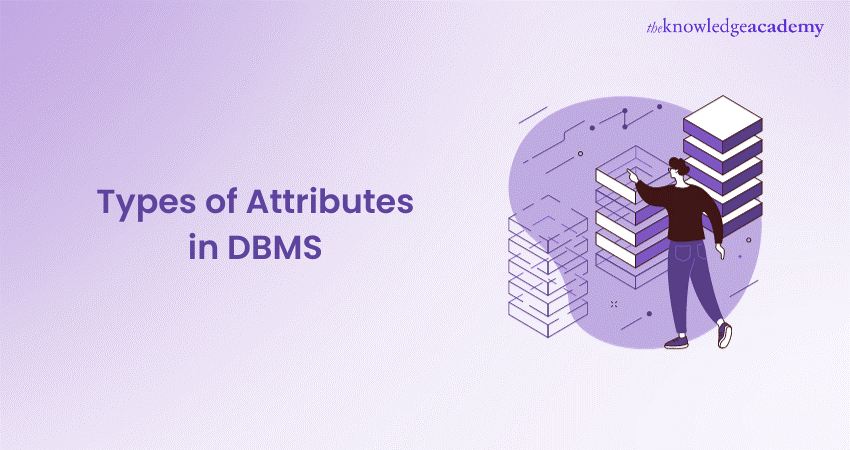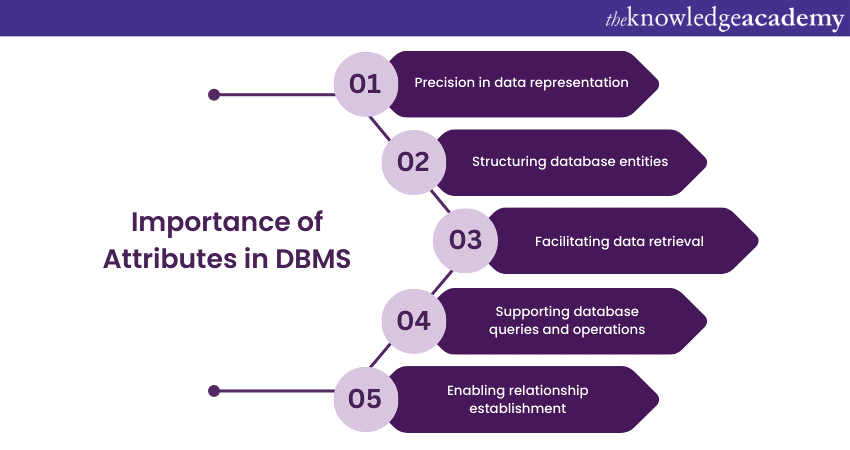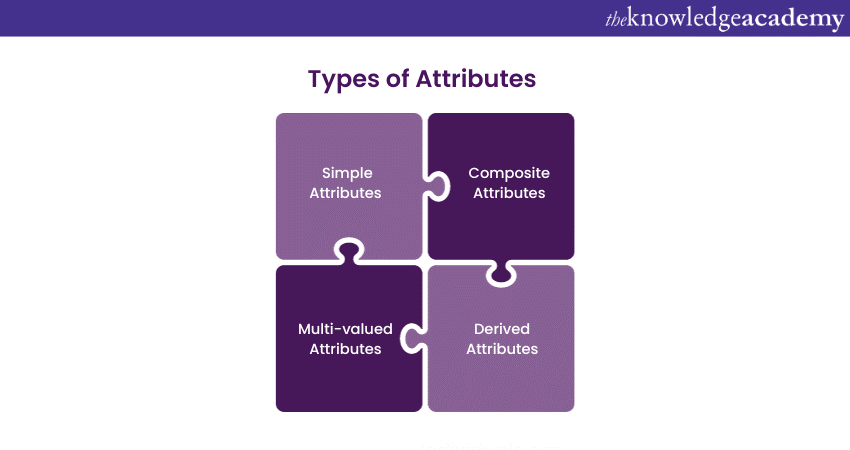We may not have the course you’re looking for. If you enquire or give us a call on + 1-866 272 8822 and speak to our training experts, we may still be able to help with your training requirements.
We ensure quality, budget-alignment, and timely delivery by our expert instructors.

In Database Management Systems (DBMS), Attributes serve as the elemental components that characterise and describe the entities within a database. An Attribute can be understood as a property or characteristic of an entity, providing essential information about the data stored in the database. Further, in this blog, we will explore the different Types of Attributes in DBMS, including simple, composite, single-valued, and multivalued Attributes. We will also discuss their significance and applications within the DBMS framework.
Table of contents
1) Definition of Attributes in DBMS
2) Importance of Attributes in Database Management System
3) Types of Attributes
4) Best practices for handling Attributes
5) Common pitfalls and how to avoid them
6) Conclusion
Definition of Attributes in DBMS
Attributes contribute to the effective organisation and retrieval of data by defining the specific details that differentiate one entity from another. For instance, in a database representing employees, Attributes could include employee ID, name, designation, and salary. Each of these Attributes adds granularity to the understanding of the stored information.
In essence, Attributes are the data elements that help define the structure and content of a database. They play a pivotal role in the process of designing a database schema, where entities are identified, and their Attributes are determined to ensure a comprehensive and well-organised representation of the data.
Importance of Attributes in DBMS
Attributes form the backbone of a Database Management System, holding immense importance in the efficient organisation, retrieval, and manipulation of data. The significance of Attributes in a DBMS can be highlighted through several key aspects, such as:

1) Precision in data representation: Attributes provide a level of granularity and precision in representing data. They define the specific characteristics of entities, ensuring that each piece of information is accurately captured. For example, in a database of customers, Attributes such as name, address, and contact number pinpoint the unique details associated with each customer.
2) Structuring database entities: Entities that represent objects or concepts in a database are defined and distinguished by their Attributes. The Attributes associated with an entity determine its identity and distinguish it from other entities. Properly defined Attributes contribute to the logical structuring of entities, enabling a well-organised and easily navigable database.
3) Facilitating data retrieval: Attributes play a crucial role in retrieving data from a database. When formulating queries or conducting searches, Attributes are the criteria for filtering and extracting specific information. Efficiently chosen Attributes enhance the speed and accuracy of data retrieval processes.
4) Supporting database queries and operations: Attributes are essential in the formulation of queries and the execution of various database operations. Whether sorting, filtering, or aggregating data, Attributes provide the basis for performing these operations. Well-defined Attributes simplify the implementation of complex queries, contributing to the overall functionality of the DBMS.
5) Enabling relationship establishment: Attributes are instrumental in establishing relationships between entities. By identifying common Attributes between entities, relationships can be defined, allowing for the creation of meaningful connections within the database. For instance, a shared Attribute like "employee ID" can establish a link between the two entities in a database containing information about employees and projects.
Register for our Relational Databases & Data Modelling Training now and take the next step towards becoming a database pro!
Types of Attributes
Attributes in DBMS come in various types, each playing a distinct role in the representation and organisation of data. A well-structured database, following principles like BCNF in DBMS, ensures efficiency and integrity. Understanding these Types of Attributes in DBMS is essential for effective database design. Let's explore the major categories of Attributes:

Simple Attributes
Simple Attributes are basic, indivisible elements that cannot be broken down further. They represent atomic, elementary facts about an entity. For instance, in a database of students, a "Roll Number" or "Date of Birth" would be considered simple Attributes. These Attributes provide fundamental pieces of information without any internal structure.
Simple Attributes contribute to the clarity and simplicity of the database schema. They are the foundation upon which more complex Attribute types may be built. Their straightforward nature makes them easy to understand and manage, forming the core elements of entity representation.
Composite Attributes
Composite Attributes are composed of multiple simple Attributes. They represent a more complex level of information about an entity. For example, an Attribute like "Address" might be composed of sub-Attributes such as "Street," "City," and "Zip Code." Composite Attributes allow for the representation of intricate details within a single Attribute.
Composite Attributes are valuable when dealing with entities that have multifaceted characteristics. They enhance the efficiency of data storage and retrieval by grouping related pieces of information together. This not only reduces redundancy but also simplifies the representation of complex data structures.
Derived Attributes
Derived Attributes are not directly stored in the database but are derived or calculated from other Attributes. These Attributes are dynamic and are generated based on specific rules or formulas. An example could be a "Total Price" Attribute in a database of products, calculated by multiplying the "Unit Price" by the "Quantity."
Handling derived Attributes involves ensuring their accurate calculation and maintenance. They are typically computed on the fly during queries or updates rather than being stored physically. Properly managing derived Attributes is crucial for maintaining data integrity and consistency.
Join our specialised Teradata Training and dive deep into advanced querying, optimisation strategies, and data warehousing!
Multi-valued Attributes
Multi-valued Attributes can have multiple values for a single entity. Consider a "Phone Numbers" Attribute for a person, which may have multiple contact numbers associated. Modelling multi-valued Attributes is essential for representing diverse sets of information within a single entity.
Implementing multi-valued Attributes requires special considerations. Techniques such as creating separate tables for multi-valued Attributes and establishing relationships can be employed to address the challenges associated with their representation in a relational database.
Best practices for handling Attributes
Effectively managing Attributes in a Database Management System is crucial for maintaining data integrity, optimising performance, and ensuring the scalability of the database. Here are some best practices for handling Attributes:
1) Choose descriptive and clear names: Use descriptive and easily understandable names when naming Attributes. This not only enhances the readability of the database schema but also helps in avoiding confusion during development and maintenance.
2) Follow a standard naming convention: Establish a consistent naming convention for Attributes across the entire database. This ensures uniformity, making it easier for developers and database administrators to navigate and understand the structure.
3) Use data types appropriately: Select appropriate data types for Attributes to optimise storage and improve query performance. For example, use integers for whole numbers and varchar for variable-length character data.
4) Document Attribute dependencies: Clearly document dependencies between Attributes, especially in cases where one Attribute's value is dependent on another. Understanding these dependencies is essential for maintaining data consistency.
5) Avoid redundant Attributes: Minimise redundancy by avoiding the storage of redundant information. Redundant Attributes can lead to inconsistencies and make data maintenance more challenging.
6) Handle null values carefully: Consider the implications and handle them consistently when allowing null values. Clearly define when null values are acceptable and when they are not. Document the reasons for allowing nulls.
Ready to conquer time-series data analytics? Join our specialised InfluxDB Training and delve into the world of high-performance, scalable data storage and analysis.
Common pitfalls and how to avoid them
Here are some common pitfalls and how to avoid them:
1) Overusing derived Attributes: While derived Attributes can be useful, overusing them may lead to increased computational overhead. Evaluate the frequency of use and complexity before deciding to derive Attributes rather than storing them directly.
2) Neglecting indexing: Properly indexed Attributes are frequently used in search and retrieval operations. Neglecting indexing can result in slower query performance, especially in large databases.
3) Ignoring multi-valued Attributes: When dealing with multi-valued Attributes, be mindful of their representation to avoid data anomalies. Consider creating separate tables or using appropriate normalisation techniques to handle multi-valued Attributes.
4) Inconsistent data types: Inconsistency in data types can lead to conversion errors and data quality issues. Ensure data types are consistent across Attributes, especially when dealing with related data.
5) Lack of documentation: Insufficient documentation can impede the understanding and maintenance of the database. Document Attribute definitions, relationships, and any business rules associated with them.
Join our dynamic GraphQL Database Training With React and discover the seamless integration of GraphQL with React for efficient, flexible, and responsive applications!
Conclusion
In this comprehensive guide, we've delved into the world of Types of Attributes in DBMS, exploring their definition, importance, and various types. Attributes serve as the foundation for effective data organisation, retrieval, and manipulation within a database.
Supercharge your career with our comprehensive Database Training.
Frequently Asked Questions
What are the Other Resources and Offers Provided by The Knowledge Academy?

The Knowledge Academy takes global learning to new heights, offering over 3,000 online courses across 490+ locations in 190+ countries. This expansive reach ensures accessibility and convenience for learners worldwide.
Alongside our diverse Online Course Catalogue, encompassing 19 major categories, we go the extra mile by providing a plethora of free educational Online Resources like News updates, Blogs, videos, webinars, and interview questions. Tailoring learning experiences further, professionals can maximise value with customisable Course Bundles of TKA.
Upcoming Programming & DevOps Resources Batches & Dates
Date
 Redis Cluster Database Training
Redis Cluster Database Training
Fri 4th Apr 2025
Fri 6th Jun 2025
Fri 25th Jul 2025
Fri 24th Oct 2025
Fri 26th Dec 2025






 Top Rated Course
Top Rated Course



 If you wish to make any changes to your course, please
If you wish to make any changes to your course, please


